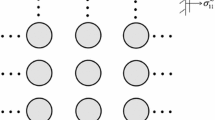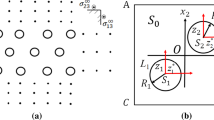Summary
We study elastic anti-plane responses of unidirectional fiber-matrix composites. The fibers are of circular cylinder shape, aligned in the axial direction, and arranged randomly, with no overlap, in the transverse plane. We assume that both fibers and matrix are linear elastic and isotropic. In particular, we focus on the effects of scale of observation and boundary conditions on the overall anti-plane (axial shear) elastic moduli. We conduct this analysis numerically, using a two-dimensional square spring net-work, at the mesoscale level. More specifically, we consider finite “windows of observation”, which we increase in size. We subject these regions to several different boundary conditions: displacement-controlled, traction-controlled, periodic, and mixed (combination of any of the first three) to evaluate the mesoscale moduli. The first two boundary conditions give us scale-dependent bounds on the anti-plane elastic moduli. For each boundary condition case we consider many realizations of the random composite to obtain statistics. In this parametric study we cover a very wide range of stiffness ratios ranging from composites with very soft inclusions (approximating holes) to those with very stiff inclusions (approaching rigid fibers), all at several volume fractions.
Similar content being viewed by others
References
Hill, R.: Elastic properties of reinforced solids: some theoretical principles. J. Mech. Phys. Solids11, 357–372 (1963).
Huet, C.: Application of variational concepts to size effects in elastic heterogeneous bodies. J. Mech. Phys. Solids38, 813–841 (1990).
Sab, K.: On the homogenization and the simulation of random materials. Eur. J. Mech. A/Solids11, 583–607 (1992).
Ostoja-Starzewski, M.: Micromechanics as a basis of random elastic continuum approximations. Probabilistic Eng. Mech.8, 107–114 (1993).
Ostoja-Starzewski, M.: Micromechanics as a basis of continuum random fields. Appl. Mech. Rev.47, S221-S230 (1994).
Ostoja-Starzewski, M.: Microstructural disorder, mesoscale finite elements, and macroscopic response. Proc. Roy. Soc. Lond. A455, 3189–3199 (1999).
Drugan, W. J., Willis, J. R.: A micromechanics-based non-local constitutive equation and estimates of representative volume element size for elastic composites. J. Mech. Phys. Solids44, 497–524 (1996).
Gusev, A. A.: Representative volume element size for elastic composites: a numerical study. J. Mech. Phys. Solids45, 1449–1459 (1997).
Ostoja-Starzewski, M., Sheng, P. Y., Alzebdeh, K.: Spring network models in elasticity and fracture of composites and polycrystals. Comp. Mater. Sci.7, 82–93 (1996).
Stoyan, D., Stoyan, H.: Fractals, random shapes and point fields. New York: Wiley 1994.
Ostoja-Starzewski, M.: Random field models of heterogeneous materials. Int. J. Solids Struct.35, 2429–2455 (1998).
Ostoja-Starzewski, M.: Scale effects in materials with random distributions of needles and cracks. Mech. Mater.31, 883–893 (1999).
Press, W. H., Teukolsky, S. A., Vetterling, W. T., Flannery, B. P.: Numerical recipes. Cambridge: Cambridge University Press 1992.
Alzebdeh, K., Al-Ostaz, A., Jasiuk, I., Ostoja-Starzewski, M.: Fracture of random matrix-inclusion composites: scale effects and statistics. Int. J. Solids Struct.35, 2537–2566 (1998).
Jiang, M.: Scale and boundary conditions effects in fiber-reinforced composites. Georgia Institute of Technology, Ph.D. dissertation, 2000.
Hashin, Z.: Analysis of composite materials—A survey. J. Appl. Mech.50, 481–505 (1983).
Hazanov, S., Huet, C.: Order relationships for boundary conditions effect in the heterogeneous bodies smaller than the representative volume. J. Mech. Phys. Solids42, 1995–2011 (1994).
Jiang, M., Ostoja-Starzewski, M., Jasiuk, I.: Scale-dependent bounds on effective elastoplastic response of random composites. J. Mech. Phys. Solids49, (3), 655–673 (2001).
Author information
Authors and Affiliations
Rights and permissions
About this article
Cite this article
Jiang, M., Alzebdeh, K., Jasiuk, I. et al. Scale and boundary conditions effects in elastic properties of random composites. Acta Mechanica 148, 63–78 (2001). https://doi.org/10.1007/BF01183669
Received:
Revised:
Issue Date:
DOI: https://doi.org/10.1007/BF01183669




